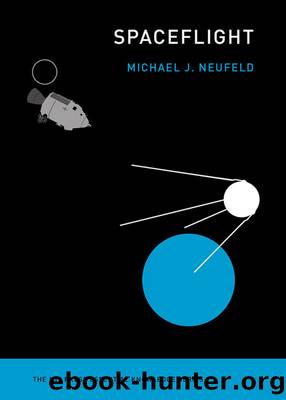Spaceflight by Michael Neufeld

Author:Michael Neufeld [Neufeld, Michael]
Language: eng
Format: epub
Tags: space exploration; cold war; space race; astronauts
Publisher: MIT Press
Published: 2018-10-25T00:00:00+00:00
In the United States, the National Reconnaissance Office flew CORONA spy satellites, which returned photographic film in reentry capsules, until 1972, supplemented by similar, high-resolution GAMBIT satellites to take close-up images of targets. Electronic methods of returning images could not produce the resolution required to be militarily useful before the late 1970s. Meanwhile, NASA launched the first experimental weather satellite, TIROS 1 (Television Infrared Observation Satellite), in April 1960, a simple spinning vehicle with TV cameras that had evolved from a losing reconnaissance proposal by Radio Corporation of America (RCA). Like CORONA, what was to be a temporary stopgap or experiment became the basis for an operational system of satellites orbiting over the poles so that all of the globe would be visible.2
At first, meteorologists needed to be convinced that images that showed mostly clouds would be useful, but most quickly concluded that it provided valuable information on weather fronts and storms. Detecting and tracking hurricanes in the open ocean greatly increased warning time. When TIROS images did not prove as useful as hoped in predicting weather over the Soviet bloc, the U.S. Defense Department built a parallel system based on the same technology. Its first and most important job was producing cloud cover predictions that would allow spy satellite operators to know when to attempt photography, so as to reduce the number of pictures of overcast targets.
The Soviets deployed their first Zenit reconnaissance vehicles in 1962, using a version of the Vostok spacecraft, as Sergei Korolev had planned from the outset. The spherical reentry module, instead of carrying the cosmonaut and his ejection seat, held the cameras, which were recovered along with the film. But the early Soviet emphasis on producing propaganda spectaculars with humans or lunar and planetary probes meant that the USSR lagged behind the United States in every practical application of space technology. The first experimental Meteor weather satellites using television cameras were not launched until 1964, and all were hidden under the generic Kosmos label until the system was declared operational in 1969.3
While the United States led the way in weather systems, it struggled with how to organize responsibility for civilian programs. NASA as an experimental and developmental agency was not the best organization to run an operational system, but it was the agency on the cutting edge of civil spacecraft and sensor development. It pursued its own Nimbus satellite project even as it transferred the simpler systems evolved from TIROS to the National Weather Service, which eventually became part of the National Oceanic and Atmospheric Administration (NOAA). Nimbus did lead to the development of instruments in infrared and microwave regions that could greatly expand what weather satellites could do. It was only when satellites could make comprehensive measurements of water vapor, cloud layers, temperatures, and other quantities, in the 1980s and later, that they began to produce data that could be fed into increasingly powerful computer models for weather prediction.4
NASA also pioneered the stationing of weather sensors in GEO. In a twenty-four-hour circular orbit at 22,300 miles over the equator, a satellite effectively hovers over one place.
Download
This site does not store any files on its server. We only index and link to content provided by other sites. Please contact the content providers to delete copyright contents if any and email us, we'll remove relevant links or contents immediately.
| Aerodynamics | Aircraft Design & Construction |
| Astronautics & Space Flight | Avionics |
| Gas Dynamics | Propulsion Technology |
Whiskies Galore by Ian Buxton(41885)
Introduction to Aircraft Design (Cambridge Aerospace Series) by John P. Fielding(33064)
Small Unmanned Fixed-wing Aircraft Design by Andrew J. Keane Andras Sobester James P. Scanlan & András Sóbester & James P. Scanlan(32744)
Craft Beer for the Homebrewer by Michael Agnew(18145)
Turbulence by E. J. Noyes(7942)
The Complete Stick Figure Physics Tutorials by Allen Sarah(7312)
Kaplan MCAT General Chemistry Review by Kaplan(6868)
The Thirst by Nesbo Jo(6832)
Bad Blood by John Carreyrou(6558)
Modelling of Convective Heat and Mass Transfer in Rotating Flows by Igor V. Shevchuk(6392)
Learning SQL by Alan Beaulieu(6213)
Weapons of Math Destruction by Cathy O'Neil(6152)
Man-made Catastrophes and Risk Information Concealment by Dmitry Chernov & Didier Sornette(5926)
Digital Minimalism by Cal Newport;(5667)
Life 3.0: Being Human in the Age of Artificial Intelligence by Tegmark Max(5478)
iGen by Jean M. Twenge(5367)
Secrets of Antigravity Propulsion: Tesla, UFOs, and Classified Aerospace Technology by Ph.D. Paul A. Laviolette(5311)
Design of Trajectory Optimization Approach for Space Maneuver Vehicle Skip Entry Problems by Runqi Chai & Al Savvaris & Antonios Tsourdos & Senchun Chai(5012)
Pale Blue Dot by Carl Sagan(4917)
